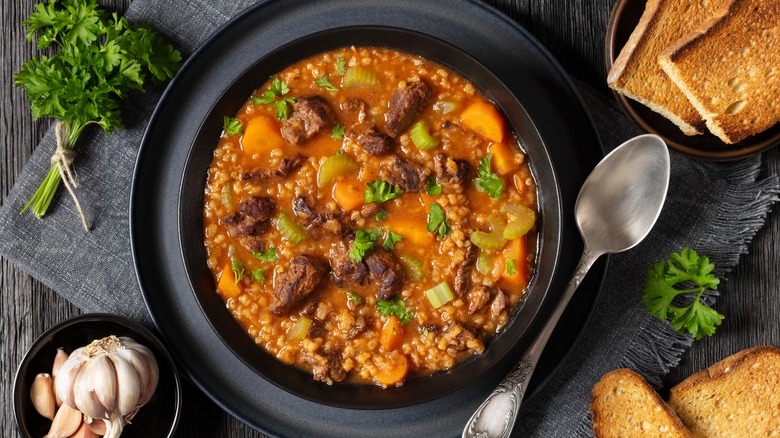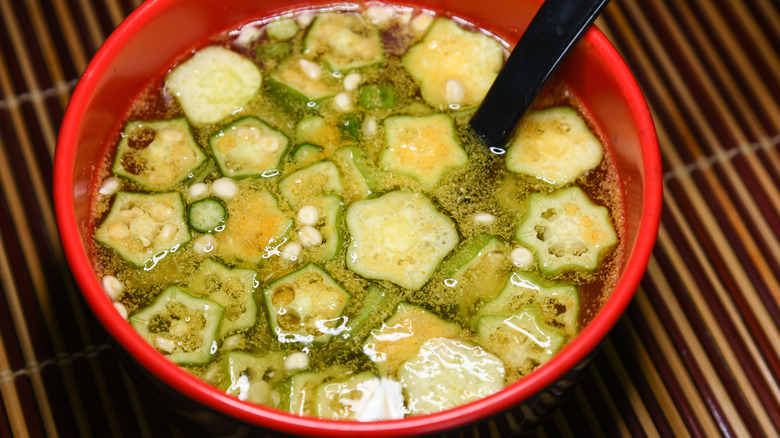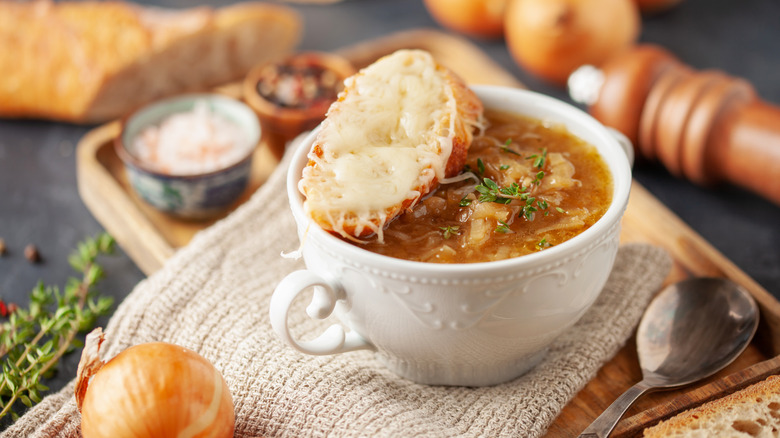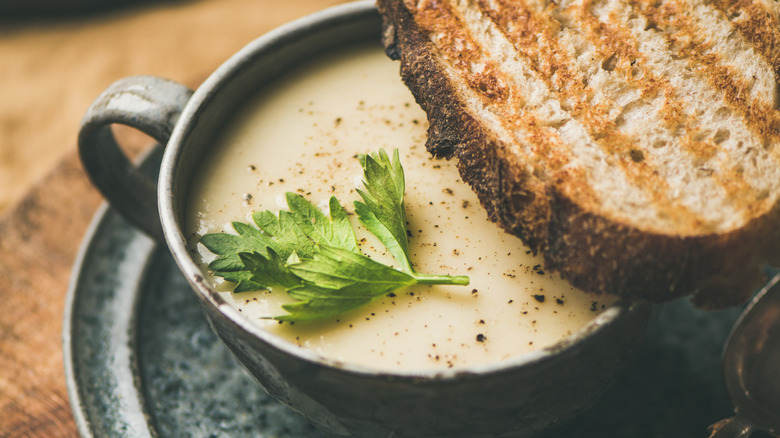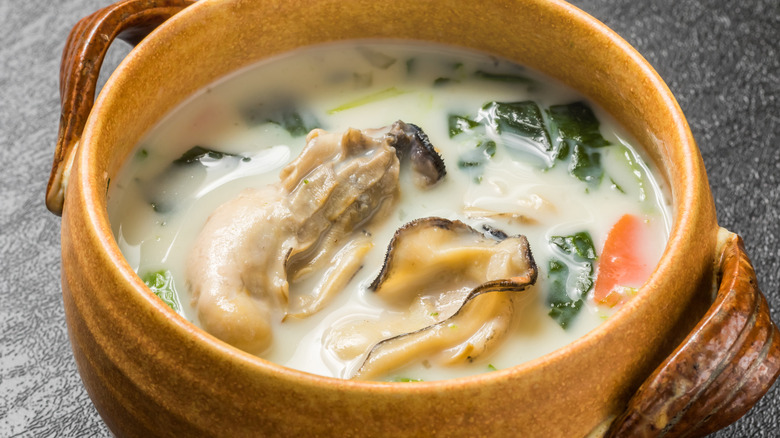10 Old-School Winter Soups That More People Need To Try
We may receive a commission on purchases made from links.
Some foods are hits any time of year, from the most perfect, juicy steak to a dollop of goes-with-everything chimichurri. Other recipes can be off the table for several months, only to make a glorious return when the appropriate season rolls around. Winter soups fall squarely into the latter category, with millions of home cooks across the United States pulling out their go-to recipes when the weather turns chilly.
Back when we had the time to nurse a simple bone broth into a well of savory flavor that sometimes took hours to cook, the resulting soups warmed homes and filled bellies as the seasons changed. Amid the ongoing online debate about when a soup turns into a stew (lumps are a key factor), tastes vary when it comes to favorites in U.S. states — though chicken is a wildly popular ingredient. Some hearty bowls aren't even seen as exclusively winter soups any more (we see you clam chowder, broccoli cheddar, and beef stew).
Part of that shift is down to the widespread availability of canned soups, which can also be used to create other delicious meals, and part of it because some ingredients have fallen out of fashion. That is a shame, because there's a world of flavor out there just waiting to light up the shorter, darker days. Here are old-school winter soups that more people need to try.
Beef barley soup
If you're asked to think of what makes up the carbs in most meals, chances are pasta, rice, noodles or potatoes come to mind. But barley? Unless you're a lover or brewer of malt beers, then probably not. It's likely not on most people's radars, despite being fantastically good for us. Hulled or whole grain barley is better than the pearl kind, but both are high in fiber, as well as a slew of vitamins and nutrients. Cooking hulled or pearl barley couldn't be easier: They are also as flexible as rice, so you can boil, steam, or fry them, bringing their slightly nutty flavor to a wide range of dishes.
It is, of course, a key ingredient in the classic winter warmer beef barley soup, a dish whose Scottish origins dates back centuries but that remained popular in the United States into the 1970s. It's ideal for home cooks on a budget, because it can be made with leftover meat, cheap stewing beef, or a shin bone full of rich marrow.
Chop in some hearty veggies like carrots, turnips, and celery, alongside a handful or two of hulled or pearl barley, and you've got the makings of a soup that powered entire populations. The recipe can be tweaked according to personal taste, too, such as adding a dash of paprika or red wine for a deeper flavor, or removing the beef for an entirely vegetarian version.
Okra soup
In India, it's known as "ladies' fingers," and in China it's called "quilobo," but in the United States, this thin, green vegetable is okra. Originally found in Ethiopia thousands of years ago, it slowly made its way across Africa and arrived in the U.S. in the 1800s, where Thomas Jefferson grew it in his Monticello garden. Dishes that included okra made by Black slaves were swiftly adopted by white Americans and written into cookbooks, bringing it to a wider audience.
Today, okra comes in a kaleidoscope of colors, as well as the commonly found green kind, and it's at the heart of many recipes found across the country. Arguably the most well known is gumbo, which gets its name from the Kimbundu word "quingombo," but okra plays either a supporting or a starring role in several soups, too. The secret lies in its "mucilage," a slimy gel that might not seem appealing, but is ideal for helping to thicken whatever it's being used in, from sauces to stews.
It's a key factor in the West African version of okra – also known as okro — soup. Like many Southern recipes, it relies on the vegetable's natural gel for its consistency, but beyond that, it's a brilliant winter soup that can be made with whatever you have to hand. Whole tomatoes, butter beans, onions, beef, and leafy greens are all tasty additions, helping okra soup pack a flavor punch.
Chestnut soup
You could be forgiven for only thinking about chestnuts when they're being roasted on an open fire, but there's so much more to this creamy, nutty ingredient, not least making for a divine winter soup. It's a mainstay in France and Germany but less so in the United States. That could be because of a fungus, brought in with imported trees from Asia in the 1950s, that all-but wiped out the American chestnut, or they were simply an ingredient that American foodies fell out of love with. But there are plenty of great reasons to give this bygone sweet, nutty treat a space at the table.
First, chestnuts are packed with health benefits, including antioxidants such as zeaxanthin and lutein, which protect our eyes against blue light. They're also a good source of fiber, and can even help control our blood sugar levels. As for cooking chestnuts, of course they're delicious roasted and in a stuffing similar to what people ate at the first Thanksgiving. But they also make a delicious winter soup.
Creamy soups work well for a variety of vegetables, from umami mushrooms through to silky butternut, and they all benefit from a range of delicious toppings. If you want to give a real old-school ingredient a 21st-century glow-up, swap out that fungi or squash for chestnuts. It's richer than potato or leek and, if you invest in a cutter like this, every bit as easy to make.
Onion soup
When people in the United States order soup at a restaurant, a lot of them plump for French onion, walking away satisfied and with no notes. It's a different story when it comes to whipping up a batch of onion soup at home. Unless they're lucky enough to possess a recipe that's been handed down by grandma, many home cooks give it a wide berth, despite it being a superb winter soup. Sure, you can buy it in a can or in a packet mix, but making it from scratch means you get the real deal.
The ancient Egyptians and Romans knew their onions — so to speak – using the vegetable in medicine as well as meals. During the winters of 1700s Paris, cafe customers slurped it down to keep out the cold, and its popularity soon spread, with French onion soup on the menus of the finest restaurants around the world. However, today in the U.S., it's among the many old-school diner foods that are no longer popular.
It's incredible, considering how relatively easy onion soup (French or otherwise) is to make, and how delicious it tastes. The trick is to make sure the onions are properly caramelized before they are slowly cooked in a beef or vegetable broth to give that intense depth of flavor. Tradition says you should top it with this cheese, but who says you can't play around and break the rules?
Tripe soup
There will be some readers who take one look at the subject of this section and ask, "What's tripe?" while others will recoil in horror. Let's get the icky part out of the way first. Tripe is the stomach of animals including pigs, cows, and sheep. It was a staple food in the United Kingdom for years at all levels of society; beloved because it was cheap, easy to digest and (though of course many didn't know it at the time) full of goodies like selenium and vitamin B12. Unfortunately, tripe suffered from a terrible image problem and has since been shunted to the U.K.'s culinary sidelines.
Not so in places like Africa, Latin America, and Turkey, where it is both prized and popular. Mondongo stew, which includes tripe, is made throughout Central and South America, and the Caribbean. It also crops up in Czech tripe soup, Romania's Ciorba de Burta, and Poland's flaki; soups that are relatively simple to prepare and incredibly tasty.
If the thought of eating tripe makes you feel queasy, the taste is milder than you might imagine — think liver flavor but dialed right down. Buying it from a butcher means a lot of the hard work has already been done. All you need to do is clean it with rock salt and vinegar, soak it in cold water for up to 10 minutes, and your tripe is ready to add to any winter soup.
Split pea soup
If ever an old-school curtain raiser was needed for soup season, it should be split pea. Americans have French-Canadian millworkers to thank for this warming dish, after they brought it to New England in the 19th century, though its Canadian history goes back much further. Like its British counterpart, pease pudding, split pea soup is thick and creamy, made with yellow split peas and a ham hock (though leftover ham will do in a pinch).
While pease pudding can be eaten hot or cold, making it an all-rounder in the seasonal soup stakes, traditional split pea is best devoured piping hot and in the depths of winter, preferably with some crusty bread to mop up every last scrap. Making it requires organization and a little bit of patience, but the results are well worth it.
Swing by your local butcher or that section of the supermarket to find a good ham bone, one with bits of meat still clinging to it is ideal, then invest in some good quality split peas. These come in a resealable bag, so you don't have to worry about spillage or storage. Then, it's a case of adding them to carrots, onions, celery, and chicken broth, and cooking the whole thing slowly for at least an hour, to let the flavor of the ham bone infuse the stock, while the dried peas absorb the liquid. Instant winter warmth in a bowl.
Celery soup
Aside from being a delivery device for cream cheese or the decoration for a Bloody Mary, many people believe there's not a lot you can do with a stick of celery. They would be wrong. Team it with finely diced carrots and onions and you'll have the basis for the only stock you'll ever need. Buy it in November or December at the start of its season, smear the straight bit of the stalk with butter and a grind of salt for a divine snack, or chop your celery into bite-sized pieces to pep up a green salad. Alternatively, give it a turn in the spotlight in a divine winter soup.
It's not that long ago that celery was everywhere on American menus, either as a side dish, an hors d'oeuvre or in a salad. But for reasons no one can really fathom, around 1950, the public appetite for the earthy-tasting vegetable fell off a cliff edge and has yet to recover, despite the enduring popularity of its cousin, root vegetable celeriac in high-end restaurants. Celery soup could be a first step back to its former heyday.
You can use the whole vegetable to make a pot of winter soup so there's no waste, and adding smooth, creamy white beans to the vegetable or chicken stock will result in a rich concoction. Throw in some cream or white wine to crank up the decadence and when it's done, you'll wonder how you managed the colder months without it.
Mulligatawny soup
Most recipes come about after careful research, trial and error or happy accidents. Mispronunciations, however, are fewer and farther between, but that's the origin story of this spicy soup that is ideal for a winter's day. Back in the days of the British Raj in India, the upper-crust colonials didn't eat family style like the locals. They stuck to tradition, and that included a soup course during dinner.
Their cooks simply added water to an existing dish called "milagu tannir," which is the Tamil phrase for "pepper water." The Brits loved it, but couldn't pronounce it, so the soup was dubbed "mulligatawny." The name — and the soup — stuck, eventually making its way back to the United Kingdom, where it's been a beloved staple, especially in pubs, ever since. But what's in it?
As with many soups, the recipe is elastic, but most versions have chopped celery, carrots, and onions as a base, with curry powder, diced chicken, beef, or pork, and stock thrown in the pan, alongside rice and chopped apple. Some people add a slug of heavy cream, others don't — it's a dish that lets you do you. Cook it slow and low, and you'll end up with a heady winter soup to warm your soul, every time.
Oyster soup
Native Americans had been eating oysters for generations before English colonists landed in the 1600s, but successive waves of immigrants quickly added this nutritious bivalve to their existing recipes. As people began to move west, they took oysters with them in the winter, creating a tradition that connects the shellfish with the festive season that still exists in the Midwest. Oyster stew is part of many families' Christmas Eve dinners, with some recipes handed down from one generation to another.
Our forebears wouldn't have known it, but oysters are full of important nutrients, including zinc and selenium. While American oyster populations, including in Chesapeake Bay, have suffered from over-harvesting and habitat loss, lots of work is being done to clean up their ecosystem and restore their numbers. Those are two great reasons why oyster soup should be more than a once-a-year menu addition: It's worth cooking up throughout the whole of winter.
If you can't get your hands on fresh oysters, crack open a can, instead. Then, it's a case of heating up some butter in a skillet, a handful of shallots or green onions (many recipes don't call for this, but it will add depth of flavor to your sauce), a dash of oyster juice, and a good slug of heavy cream or half and half. Just before the liquid boils, throw in the oysters, cook them for about a minute, then season and serve with crusty bread. Delicious.
Cabbage soup
In Roald Dahl's "Charlie and the Chocolate Factory," young Charlie Bucket and his family ate nothing but cabbage soup for supper, while the lad dreamed of all things chocolate. Okay, so eating cabbage soup all the time isn't good for your health, no matter what the internet says about it as a diet, it's not as gloomy as all that. In some cultures, the cabbage is regarded as a bringer of good luck, and while Poland's kapusniak is an all-year fave, we think it works best in the United States as a delicious winter soup.
First, the health benefits. Eaten in moderation, a bowl of cabbage soup will top up our iron and vitamin A levels, boost digestion, and can help lower our blood pressure. Second, there are numerous types of cabbage to choose from. Smooth, pale green cabbage is firm and slightly sweet, red cabbage brings a vivid burst of color and drama to any dish it's added to, while crinkly savoy takes the texture of any soup to the next level.
Finally, it's a more versatile vegetable than many home cooks might think, bringing all that flavor, color, and texture to lighter, fully veggie broths, as well as heartier soups made with meat, pasta or beans. Far from being lackluster, a great cabbage soup can serve up enough comfort to make even Charlie Bucket happy.

